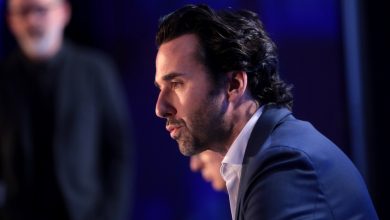A Rural Student Sought a Faraway College. Then Came a Frustrating Setback.

(This is the third article in a series on college applicants and the circumstances that shaped their choices this spring.)
The high-school senior longed to leave despite her fondness for Palouse — and in some ways because of it. She needed to experience a different place and learn how to live on her own: “I want to assemble within myself the ability to be self-reliant.” She wanted to prove that she could thrive in another place and then be able to say, “I did this.”
So she researched colleges several hundred miles from the two-story converted double-wide trailer with tan siding that she shares with her parents, grandmother, and a black labradoodle named Max. She let herself imagine heading to California, to Texas, or across the continent to upstate New York.
Fealy, a reflective young woman who plans to study actuarial science, knew her family didn’t have much money to put toward college. Her father works in the information-technology division of an engineering laboratory. Her mother is the primary caregiver for her own mother. They had socked away all their savings for retirement in regular bank accounts, Fealy says: On paper they appeared much wealthier than they really were.
But Fealy had a plan. She believed she could unlock the gates of otherwise unaffordable colleges with help from the Reserve Officers Training Corps. So last summer she applied for nationally competitive ROTC scholarships offered by the U.S. Air Force and Navy. It was a rigorous process. She sat for interviews and secured recommendations. She submitted high-school transcripts and sent score reports proving that she met the ACT/SAT minimums. And she completed fitness tests requiring push-ups, sit-ups, and a mile or more of running.
Snagging a big ROTC scholarship wasn’t easy, but Fealy thought she had a good shot. She had a perfect grade-point average and was on her way to being named valedictorian of Garfield-Palouse High School. She played softball and volleyball. And she had served in student government and the National FFA, formerly known as the Future Farmers of America. Depending on how things shook out and where she enrolled, she could get a substantial amount of funding for college — or close to a full ride.
The prospect of earning one or both ROTC scholarships shaped Fealy’s thinking about prospective colleges. She whittled her list down to campuses with an Air Force or Navy ROTC program so she could use the scholarships if she won them. She applied to Clarkson University, in Potsdam, N.Y., thinking the small campus would help her adjust to being away from home. Its proximity to the Canadian border enticed her.
Fealy didn’t want to limit herself to one kind of college. She also applied to Baylor University, in Waco, Tex., thinking she might like to attend a Christian institution with a large campus full of opportunities. After absorbing the sunshine of San Diego while visiting a cousin, she decided to apply to the University of San Diego, a Catholic institution. She also would apply to the University of Idaho and to Washington State University’s main campus, in Pullman. The latter, a short drive from Palouse, was a backup option.
After completing the Free Application for Federal Student Aid last year, Fealy saw her Expected Family Contribution, a figure she doesn’t want to share publicly: “It was absurdly high. I was like, OK, that’s not gonna happen.” Everything would depend on an ROTC scholarship. If she got one, she would probably have a handful of good choices.
Money for college wasn’t the only reason that the ROTC appealed to her. Fealy had always wanted to serve in the military, as her father did. She loved her country and wanted to give something back. She believed her years of service would give her an inner strength.
October brought good news: Fealy received an Air Force ROTC scholarship. A few weeks later, she got a Navy ROTC scholarship, too. Relief washed over her. You are so set, Denni, she thought. Her parents took her to a restaurant to celebrate, and she ordered a sirloin steak.
Everything seemed to be coming together.
But numerous factors can limit those choices. Where students live. What they want to study. Whether they can even get in. And how much financial assistance they end up receiving.
Fealy saw an ROTC scholarship as a way to give herself more choices — and better ones. But the many systems that determine a student’s options are opaque, doling out consequences that often seem random, surprising, even cruel.
After winning the two ROTC scholarships, Fealy underwent a required physical examination and completed a medical questionnaire that asked her to list any medications she had been taking. She put down Nortriptyline, which her doctor had prescribed for a gastrointestinal problem that was causing her discomfort.
Several weeks later, Fealy got shocking news: She had been disqualified from both scholarships. The reason, she learned, was that Nortriptyline is often prescribed for depression. And taking an antidepressant is a disqualifying condition for serving in the U.S. military for a year after one stops taking the drug.
It was not me making the choice. It was the money. I made the smart choice to have a backup school, but that was about as far as my choice went in the end.
At first, Fealy thought she could reverse the decision with help from her doctor. She could explain that she had taken the drug just briefly and wasn’t being treated for any mental-health conditions. But her appeals failed. The Navy ROTC, she says, told her she could reapply after a year.
Though Fealy tried to stay positive, one day, she says, “it finally just broke me.” She had always thought of fairness like this: It wasn’t a matter of getting everything you wanted but of having the chance to fight for it. She felt as if she had been robbed of the opportunity. Two scholarships, snatched from her hands.
Fealy sulked for a day or so. She distracted herself with powerlifting, yanking nearly 300 pounds off the floor. She threw herself into her routines, like working at Palouse Family Foods, where she mopped floors, washed windows, stocked shelves. In school her mind kept wandering.
Fealy got into Clarkson, her first choice. If she had been able to keep her Air Force ROTC scholarship, she could’ve converted it into one that covers up to $18,000 in tuition and fees a year for three years at public or private colleges. Clarkson offered her about $42,000 in grants and scholarships, leaving her with a gap of about $30,000. With the help of some noninstitutional scholarships she received, her family could’ve managed to finance her first year at Clarkson, she says.
But after that? Finding a good part-time job in a small town seemed like an uncertain proposition. Fealy worried that she would just end up having to transfer because she wouldn’t be able to keep paying.
Fealy had hoped to use the Navy ROTC scholarship at San Diego, her second choice. It would have covered tuition, fees, and books for four years. And the university apparently would’ve covered all or most of her room and board if she had enrolled with the scholarship. But her hopes didn’t matter: San Diego waitlisted her. Though she was accepted at Baylor, it offered her less financial aid than Clarkson did.
Finally, Fealy decided to enroll at Washington State, about a 20-minute drive from her home. She chose the university, known as Wazzou, because it offered her a Regents scholarship, $4,000 a year for four years. Idaho, which also accepted her, didn’t offer her any scholarships, she says.
For a long time Fealy had resisted the idea of enrolling at Wazzou because the campus was so close to home. But she didn’t see any alternative. “It was not me making the choice,” she says. “It was the money. I made the smart choice to have a backup school, but that was about as far as my choice went in the end.”
Washington State’s total cost of attendance for in-state students is roughly $25,000 a year. She qualified for a second scholarship, good for $4,000 a year for two years. But she was told she could not combine it with the Regents scholarship. That, she was disappointed to learn, was just how the rules of the system worked.
Despite her initial disappointment, Fealy had warmed to Washington State. The large institution could offer her many opportunities, including the chance to study abroad. She planned to live on campus for at least her first year, then maybe apply for a resident-assistant position. Some outside scholarships she received would help pay for her first two semesters. She would be working part time, too.
Fealy would do her best to pretend that she was hours from home instead of just minutes. She didn’t want to get into the habit of heading back to Palouse, where things felt comfortable, where everyone knew her name, where she had played for the same softball coach since age 5.
On a Sunday in late May, Fealy was doing the usual things. After church she went home and saw her cracked driveway and the big oak tree and the old rosebush. She ate a turkey sandwich for lunch. She planned to crash on the couch and watch some TV, then work out. Her house was on a hill from which she could see acres and acres of green wheat fields. By the time they turned gold in late summer, she would be living in a dorm at Washington State.
Fealy kept thinking about what her first week on campus would be like. She felt out of practice in making friends, which she hadn’t really done since kindergarten: Her classmates had known one another all their lives. Lately she had been joking with her peers, asking them, “How do you make friends? Do you remember how we became friends? Because I don’t!”
The prospect of meeting many people — of experiencing “the tiptoe nature of new relationships,” as she puts it — felt scary and exciting all at once. She wanted to embrace that feeling.
She didn’t want to stay in a nest. A college-bound classmate of hers was trying to secure a single dorm room with a private bathroom, but Fealy thought that wouldn’t suit her at all. “There’s a point where you can fall so heavily into yourself,” she says, “that you lose out on parts of your life.”
Fealy would refuse to spend her freshman year holed up alone in her dorm watching Netflix and staring at her phone. She would venture out to the library, the student center, everywhere.
Denni Fealy didn’t feel as if she got to pick her college, but she could choose how to live once she got there.
Source link






